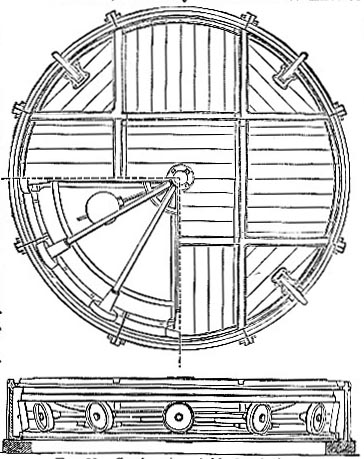1902 Encyclopedia > Railway, Railways (Railroad) > Railway Station Fittings: Switches; Factoring Points; Turntables; Traversers; Water Cranes.
Railway, Railways
(Part 22)
C. RAILWAY CONSTRUCTION (cont.)
Railway Station Fittings: Switches; Facing Points; Turntables; Traversers; Water Cranes.
The use of switches and crossings is to form a link of communication between one line of rails and another. They are either constructed with ordinary rails or with rails specially rolled, and are carried in cast-iron chairs spiked down to sleepers. The switch-rails are movable, and when worked independently are moved by rods to which heavy weights are attached,—the function of the weights being to retain the points in one position, and to act as a self-acting adjustment in restoring them to their normal position after they have been shifted for the passage of a vehicle or a train. When only one of the terminal rails is movable it is called a single switch and is used only on sidings or branch lines of rail. The double switches, being more perfect in action, are adopted on the main line; and, as a general rule, switches on the main line are ordered to be laid with the points in the direction of the traffic, so that passing trains may run out of the points, and not into them. "Facing-points," as they are termed, are such as are laid on the main line, facing or pointing towards the regular advancing trains. Many accidents have been caused to trains by facing-points, improperly set or out of order, turning the train unexpectedly into a siding, when it was impossible to pull up in time to prevent a collision, or throwing the train off the rails altogether. So dangerous are facing-points felt to be particularly on high-speed lines, that on some railways they are absolutely forbidden at all except at terminal stations and at intermediate stations where every train is ordered to stop. In some situations this rule can only be followed by sacrificing simplicity and increasing the number of backing-points; but it no doubt diminishes the risk of accident.
Turn-tables are of two classes,—for turning carriages and waggons, and for turning engines and tenders together. Those ordinarily used are of cast-iron, and carry two transverse lines of rails. They revolve upon a central pivot and conical rollers near the circumference, which are upheld by and turn upon a cast-iron base bedded in cement, or a built foundation (see fig. 22).

Fig. 22. Carriage turn-table for stations.
For turning engines and tenders together turn-tables about 40 feet long are required. A common plan of table consists of two longitudinal balks of timber, to carry a line of rails, framed together with cast-iron beams in such a way that the centre is supported on a pivot and the extremities on rollers. The table revolves, in a pit about 4 feet deep, on a large circular race of cast-iron bedded on a firm foundation to carry the rollers, and the motive force is applied by means of gearing. In situations where there is much traffic it is needful to extend the deck of the table laterally, like wings, to complete the circle, and so cover in the pit.
Traversers are a convenient substitute for turn-tables, particularly for working a number of parallel lines of rails. A traverser is simply a low rectangular frame, made with two overhanging rails, to receive carriages or waggons, and movable on rollers across the lines of rail, so as to receive the carriages from any one line of rail and deposit it on any other.
Water-cranes for delivering water to locomotives are too familiar to every one to need description.
Read the rest of this article:
Railway, Railways - Table of Contents
|
